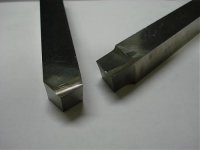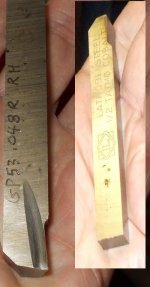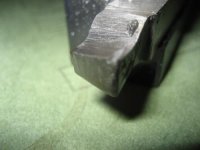You are using an out of date browser. It may not display this or other websites correctly.
You should upgrade or use an alternative browser.
You should upgrade or use an alternative browser.
Tapering a straight barrel.
- Thread starter Bnhpr
- Start date
JerrySharrett
Senile Member
A long time ago, I remember an experienced local gunsmith telling someone, who was going to try this for the first time, to use a very sharp pointed HSS tool and move it down the barrel rapidly, using shallow cuts, to prevent heating. The finish was like awful looking shallow threads, but it didn't matter, since he had a floor mounted long belt sander, and a barrel spinner. The most important thing was to keep the barrel as cool as possible.
This is not a good photo but all I have on this computer for now but the second tool from the front is generally what you need. This being a HSSCo bit it will eventually get dull but should not chip. Tapering a barrel with most carbide geometries will not usually work since the first sign of chatter the edge will fracture.
Looking closer at the picture that tool could use more lip that what this one has. And like Boyd suggests, use enough feedrate to stay ahead of the heat. Doing this lets the heat get carried off in the chip.

D
Dennis Sorensen
Guest
I turn barrels unsupported between centers with an offset live center slow with light cuts... 20 thou off the diameter. It takes a long time and you can't charge much for it. I do this as little as possible. Been doing it for 40 years. It took a lot of experimenting to get to a stage that works well for me.
This is a pretty delicate chip curler I grind. It wears down fairly quickly if the rpm is fast.


My offset live center... nothing fancy but it works well.



My offset live center... nothing fancy but it works well.

Last edited by a moderator:
JerrySharrett
Senile Member
I turn barrels unsupported between centers with an offset live center slow with light cuts... 20 thou off the diameter. It takes a long time and you can't charge much for it. I do this as little as possible. Been doing it for 40 years. It took a lot of experimenting to get to a stage that works well for me.
This is a pretty delicate chip curler I grind. It wears down fairly quickly if the rpm is fast.
My offset live center... nothing fancy but it works well.
Beautifully lipped tool Dennis. I can barely remember the day I could see that well but that deep lipped HSS or HSSCo is exactly that is needed when machining barrels. Any carbide tool, cemented, built-in chipbreaker, or clamp-on chip breaker will not do as well as this grind geometry.
Ben,
Did you ever figure out what Bill Leeper was recommending for a HSS tool grind or did you go with the carbide you had in the picture?
I do have a pneumatic follow rest to hopefully eliminate chatter.
Ridz
I tried both and did better with my own tools. I had something similar to Dennis' below.
Carbide takes more pressure and more heat. I do not have coolant on my lathe at home. So, I was hand pouring with a drip pan. pita
The end product was a fairly heavy bbl, so, the tolerances may not have changed that much..who knows, but if you widdle one down to a mountain rifle bbl, It would probably be a mess.
Attachments
JerrySharrett
Senile Member
Ben, hand pouring coolant on carbide is not a good idea especially if it is something like a water soluble coolant as it can heat fracture the carbide. A thin coat of cutting oil works fine but even pouring oil on irregularly can also fracture carbide if you are running a higher surface footage speed.I tried both and did better with my own tools. I had something similar to Dennis' below.
Carbide takes more pressure and more heat. I do not have coolant on my lathe at home. So, I was hand pouring with a drip pan. pita
.
Your tool grinding looks good but the tool on the left should be positioned to the cut at about a 10-15 degree leade angle. i.e., creating a shoulder of about 10-15 degree slope. Too steep of slope causes too much contact area area for a depth of cut. Conversely, cutting as a square shoulder will can give some chatter as the cut starts to taper out.
A tip if you are using a larger lathe that has a taper attachment, hold about 1"-2" in the chuck will support the barrel as this gives less chatter than running totally between centers and driving the barrel with a lathe dog.
R
Ridz
Guest
Thanks....
Thanks guys, this is exactly the type of information I was looking for, it's true, a picture is worth a thousand words. Any and all additional info is appreciated.
Ridz
Thanks guys, this is exactly the type of information I was looking for, it's true, a picture is worth a thousand words. Any and all additional info is appreciated.
Ridz
Ben, hand pouring coolant on carbide is not a good idea especially if it is something like a water soluble coolant as it can heat fracture the carbide. A thin coat of cutting oil works fine but even pouring oil on irregularly can also fracture carbide if you are running a higher surface footage speed.
Your tool grinding looks good but the tool on the left should be positioned to the cut at about a 10-15 degree leade angle. i.e., creating a shoulder of about 10-15 degree slope. Too steep of slope causes too much contact area area for a depth of cut. Conversely, cutting as a square shoulder will can give some chatter as the cut starts to taper out.
A tip if you are using a larger lathe that has a taper attachment, hold about 1"-2" in the chuck will support the barrel as this gives less chatter than running totally between centers and driving the barrel with a lathe dog.
I do not have a taper attachment.
I used the steel tooling primarily for the aforementioned job.
In fact the only carbide i'm using at all for gun work is small boring bars with soldered tools, for preboring before chambering.
Ben
Bill Leeper
New member
The tool as shown by Dennis is pretty well what I have always used to turn barrels. Plainly, my descriptive abilities are lacking! A good cobalt steel is best. I also grind a similar tool of carbide which lasts better but, since the edge can't be ground as fine, creates a little more pressure at the cut.
The tool is set a bit above center. I cut as heavy and as deep as possible.
Ron Smith uses a Kennametal "Top Notch" tool which works well for him. He has a cleverly made vibration damping follow rest which does a lot to damp out chatter I've been going to rig up a similar system for about eight years now but get along OK without it so might never get it done. Regards, Bill.
The tool is set a bit above center. I cut as heavy and as deep as possible.
Ron Smith uses a Kennametal "Top Notch" tool which works well for him. He has a cleverly made vibration damping follow rest which does a lot to damp out chatter I've been going to rig up a similar system for about eight years now but get along OK without it so might never get it done. Regards, Bill.
jackie schmidt
New member
Tools
I can have my choice of any tool steel, carbide, insert, or what ever, and I can grind a tool that is identicle to what Dennis posted, except out of 883 cemented carbide. To do it in Carbide, you really need a tool grinder.
About the only thing I can add from the other excellent answers is keep the nose radius as small as possible. That is usually the source of chatter and vibration..........jackie
I can have my choice of any tool steel, carbide, insert, or what ever, and I can grind a tool that is identicle to what Dennis posted, except out of 883 cemented carbide. To do it in Carbide, you really need a tool grinder.
About the only thing I can add from the other excellent answers is keep the nose radius as small as possible. That is usually the source of chatter and vibration..........jackie
R
Ridz
Guest
Merry Christmas to all
I will be using a pneumatic follow rest built on Mark Strattons design.
I assume that artwork of a chipbreaker Dennis ground was done using a dremel tool with a diamond burr, I have to get some of them.
Should the chipbreaker be located as part of the cutting edge or located some distance away from the cutting edge, leaving a lip as in Jerry,s pic?
Regards,
Pat
I will be using a pneumatic follow rest built on Mark Strattons design.
I assume that artwork of a chipbreaker Dennis ground was done using a dremel tool with a diamond burr, I have to get some of them.
Should the chipbreaker be located as part of the cutting edge or located some distance away from the cutting edge, leaving a lip as in Jerry,s pic?
Regards,
Pat
L
luke wads
Guest
polishing said barrels
here what i have done in past
used tapper turner with no steedy , the barrel dose chatter 260rpm feed .006'' there is no wrapping othe steel
while the barrel is set up in the lathe used a angel grider with 100 grit sanding disc to polish out the tool marke barrel spining ar 500rpm getts nice finish in no time !
here what i have done in past
used tapper turner with no steedy , the barrel dose chatter 260rpm feed .006'' there is no wrapping othe steel
while the barrel is set up in the lathe used a angel grider with 100 grit sanding disc to polish out the tool marke barrel spining ar 500rpm getts nice finish in no time !
D
Dennis Sorensen
Guest
I will be using a pneumatic follow rest built on Mark Strattons design.
I assume that artwork of a chipbreaker Dennis ground was done using a dremel tool with a diamond burr, I have to get some of them.
Should the chipbreaker be located as part of the cutting edge or located some distance away from the cutting edge, leaving a lip as in Jerry,s pic?
Regards,
Pat
I rough the little hollow out with a cut off tool in a Dremel and then finish it with a small grinding stone. I like a small trough as it finish grinds sooner but a larger one will work fine. If you have a small diamond burr it would work well too.
JerrySharrett
Senile Member
Ridz, look closer. There may be an illusion that there is a flat between the cutting edge and the lip, but there isn't. What you want is a high relief clearance to cause there to be less cutting pressure, just like a sharp knife.I
Should the chipbreaker be located as part of the cutting edge or located some distance away from the cutting edge, leaving a lip as in Jerry,s pic?
Regards,
Pat
As Ferris Pindell said " a keen little edge".
That tool I pictured is a regrind and I don't see as well as I did a few decades ago!! It is a victim of some fits and starts to get the corner of the grinding rock back to where it should be to resharpen the edge.
C
chris k
Guest
barrel turning
Anyone who has not had the opportunity to turn a barrel should .One soon appreciates the preturned barrels. The time consumed to set -up , keep tools bits sharp ,find the right feed , keep the tool bit from chattering ,resharpen bits , and get a good finish as well has get the proper profile needs to be experienced .
Chris
Anyone who has not had the opportunity to turn a barrel should .One soon appreciates the preturned barrels. The time consumed to set -up , keep tools bits sharp ,find the right feed , keep the tool bit from chattering ,resharpen bits , and get a good finish as well has get the proper profile needs to be experienced .
Chris
K
kevin_j
Guest
So following you all's lead here, I ground up a bit last night to experiment with. I ran it at around 360 RPM, .007 IPR, and played with DOC a bit. Best I got was .040 before my little Clausing 5914 started chattering. Material removal was pretty good on a drop of 4140 cut off a Pac-Nor CM.
I really like the chip formation using this cutter! Anybody have experience using this with LW50? Profiling that stuff has been extremely problematic. Very bad tendency to form very long, very sharp chips that birds nest.
Thing that was interesting was the surface finish. It was pretty rough! I know it's not a finishing cutter, but I was surprised at how it looked I must have something wrong. Any ideas? Sorry for the bad pics.
Thanks,
Kevin
I really like the chip formation using this cutter! Anybody have experience using this with LW50? Profiling that stuff has been extremely problematic. Very bad tendency to form very long, very sharp chips that birds nest.
Thing that was interesting was the surface finish. It was pretty rough! I know it's not a finishing cutter, but I was surprised at how it looked I must have something wrong. Any ideas? Sorry for the bad pics.
Thanks,
Kevin
Attachments
ultramagmed
JKM
Kevin,


These are the four that I use most. The two in the center I bought pre-ground and the two outer ones I ground myself (as I'm sure you can tell).I use 360 rpm with .0011 ipr. I don't usually take more than .020 doc, and I also setup my steady rest in the middle to avoid chatter and then cut that part of the barrel last and file and polish to match. This is just what has worked for me with my limited experience in barrel contouring.
Med.


These are the four that I use most. The two in the center I bought pre-ground and the two outer ones I ground myself (as I'm sure you can tell).I use 360 rpm with .0011 ipr. I don't usually take more than .020 doc, and I also setup my steady rest in the middle to avoid chatter and then cut that part of the barrel last and file and polish to match. This is just what has worked for me with my limited experience in barrel contouring.
Med.
ultramagmed
JKM
Wow, sorry those are so big!!!
Med.
Med.
D
Dennis Sorensen
Guest
I don't try and get a smooth cut... it is more like a fine thread... I find a smooth cut will go all to hell in the middle of the barrel into a bad chatter... a cut like a 'fine thread' will not chatter as easily.
I use a hand held barrel spinner and a belt sander to finish the barrel.
I use a hand held barrel spinner and a belt sander to finish the barrel.





